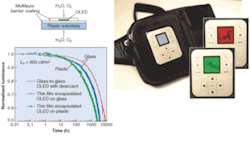When it comes to competing with liquid-crystal displays (LCDs) in the lucrative consumer electronics market, organic light-emitting-diode (OLED) displays have been hampered by limited lifetimes and higher production costs. While it is widely acknowledged that OLEDs offer better brightness, contrast, and color, they still suffer from degradation problems. The key challenge for OLED manufacturers is to develop hermetic packaging with adequate barrier films that protect the OLED materials from degrading when exposed to moisture and oxygen, particularly with polymer-based displays.
In fact, one of the inherent advantages of OLED materials is their ability to be applied to polymer substrates, which should open up new applications in the electronics market that LCDs cannot address. Besides changing the form factor for existing products such as cell phones and laptop computers, being able to cover plastic and other materials with an OLED-based coating is expected to create a new generation of flexible electronic displays, including "roll-up" electronic newspapers, books, TVs, and personal multimedia communication and computing devices.
Challenges
In general, a long-lifetime flexible OLED display on plastic poses two major challenges: preventing moisture and oxygen diffusion into the display area from the bottom and from the top. With these challenges—and the potential payoffs—of polymer OLED displays in mind, engineers from Universal Display (Ewing, NJ) have collaborated with colleagues from Vitex Systems (San Jose, CA) to develop monolithic, multilayer barrier encapsulation technology that improves the lifetimes of passive-matrix OLED displays on flexible polymer substrates (see Laser Focus World, April 2003, p. 9). Anna Chwang and colleagues at Universal Display and Vitex have demonstrated flexible OLED displays based on highly efficient electrophosphorescent OLED technology deposited on barrier-coated plastic and hermetically sealed with an optically transmissive multilayer barrier coating.1
According to the researchers, preliminary lifetimes on the order of 200 hours have been achieved using passive-matrix displays with 80 dpi resolution grown on 178-um-thick barrier-coated polyethyleneterephthalate (PET) substrates (see figure). Chwang said longer display lifetimes are achievable and notes that 2500-h lifetimes have been demonstrated on an encapsulated 5-mm2 flexible OLED test pixel on barrier-coated PET. "Our current limitations are based primarily on the temperature constraints of the plastic; for example, we cannot fully bake out certain components of the display that may be outgassing harmful solvents or water that would accelerate OLED degradation," she said. "Using a different substrate that can withstand higher temperatures, such as steel foil or a high-glass-transition-temperature plastic, or getting rid of the outgassing and moisture-absorbing components altogether, should help."
A thin-film encapsulated OLED is fabricated on barrier-coated plastic (top, schematic). Normalized lifetime data under direct-current drive were taken (top, graph) for a phosphorescent OLED on glass (red), thin-film-encapsulated phosphorescent OLED on glass (blue), and thin-film-encapsulated phosphorescent OLED on plastic (green). Half-lives of the devices are 9000, 3700, and 2500 h, respectively. The encapsulated OLED on plastic can be incorporated into personal electronic devices (bottom).
Chwang also noted that required lifetime depends on the application. Within the industry, target lifetime is typically stated to be 10,000 h; however, there may be plenty of applications in which only hundreds of hours may suffice, such as inexpensive and disposable toys and accessories that are particularly well suited to plastic displays.
Another key issue is flex. For engineers at Universal Display, the ultimate goal is the universal communication device (UCD), a handheld electronic device with a flexible OLED display screen that rolls up to be stored in the device's penlike housing. According to Chwang, products such as the UCD would require the display to survive repeated in-flex use. Initial flex test results with the current thin-film encapsulated OLED displays indicate that they suffer some damage after being flexed under tensile stress around a 1-in.-diameter cylinder. The display was flexed along the rows and under tensile stress 1000 times around the cylinder at a rate of 12 flexes/min. After 100 flexes, the display showed no damage. However, after 500 and 1000 flexes, multiple defects—primarily cathode breaks—were observed.
"The smaller the scroll diameter, the more compact the UCD," she said. "Currently we perform our flex testing at 1-in. diameter and flex the display up to 1000 times. Acceptability with respect to defects will be correlated with product lifetime and, ultimately, will be dictated by the end user."
She notes, however, that many applications would not require repeated flexing or any flexing at all. A cell-phone manufacturer, for example, may find a thin-film-encapsulated flexible OLED display attractive because of its thinness and light weight, while an auto manufacturer might want to supplant certain glass-based components with plastic displays because the latter are more robust. Cost is also an important consideration; according to Chwang, the more automated the process, the more likely it is that the manufacturing cost will be low.
"There is some debate as to whether OLED displays on plastic can be made in a roll-to-roll process," she said. "In any case, the target in the end is a plastic display that costs less than glass."
REFERENCE
- A. B. Chwang et al., Appl. Phys. Lett. (July 21, 2003).
